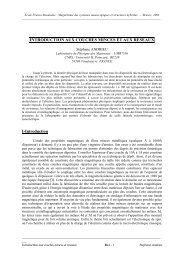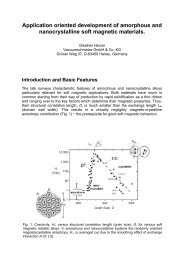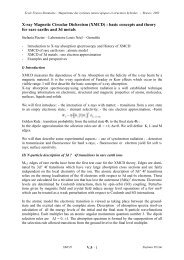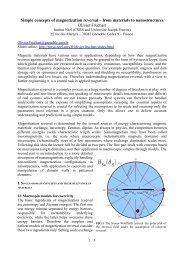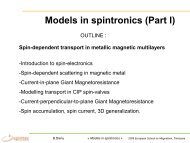FERROFLUIDS - The European School on Magnetism
FERROFLUIDS - The European School on Magnetism
FERROFLUIDS - The European School on Magnetism
Create successful ePaper yourself
Turn your PDF publications into a flip-book with our unique Google optimized e-Paper software.
1. INTRODUCTION<br />
Ferrofluids (known also as magnetic fluids) are a special category of smart nanomaterials,<br />
in particular magnetically c<strong>on</strong>trollable nanofluids [1]. <str<strong>on</strong>g>The</str<strong>on</strong>g>se types of nanofluids are<br />
colloids of magnetic nanoparticles, such as Fe 3 O 4 , γ-Fe 2 O 3 , CoFe 2 O 4 , Co, Fe or Fe-C,<br />
stably dispersed in a carrier liquid [2]. C<strong>on</strong>sequently, these nanomaterials manifest<br />
simultaneously fluid and magnetic properties. Macroscopically, the introducti<strong>on</strong> of<br />
magnetic forces into the fundamental hydrodynamic equati<strong>on</strong>s for the quasihomogeneous<br />
magnetizable liquid medium gives rise to the magnetohydrodynamics of magnetic<br />
nanofluids (ferrofluids), known also as ferrohydrodynamics and opens up an entire field<br />
of new phenomena [3] and promising applicati<strong>on</strong>s [4]. From a microscopic point of view,<br />
l<strong>on</strong>g-range, attractive van der Waals and magnetic forces are ubiquitous and therefore<br />
must be balanced by Coulombic, steric or other interacti<strong>on</strong>s to c<strong>on</strong>trol the colloidal<br />
stability of dispersed nanoparticle system, even in intense and str<strong>on</strong>gly n<strong>on</strong>-uniform<br />
magnetic field, specific to most of the applicati<strong>on</strong>s [5, 6].<br />
Many of the envisaged applicati<strong>on</strong>s, e.g., rotating seals or bearings, require magnetic<br />
fluids with high magnetizati<strong>on</strong> and at the same time, with l<strong>on</strong>g-term colloidal stability.<br />
<str<strong>on</strong>g>The</str<strong>on</strong>g>se requirements are difficult to fulfill simultaneously and implies severe c<strong>on</strong>diti<strong>on</strong>s<br />
<strong>on</strong> the stabilizati<strong>on</strong> procedures applied during the synthesis of magnetic nanofluids.<br />
<str<strong>on</strong>g>The</str<strong>on</strong>g> compositi<strong>on</strong>, structure and properties of various types of ferrofluids will be presented,<br />
refering also to technological and biomedical applicati<strong>on</strong>s envisaged for these nanofluids<br />
[2, 5].<br />
2. SYNTHESIS OF <str<strong>on</strong>g>FERROFLUIDS</str<strong>on</strong>g><br />
<str<strong>on</strong>g>The</str<strong>on</strong>g> synthesis of ferrofluids has two main steps: (a) the preparati<strong>on</strong> of nano-sized<br />
magnetic particles (2-15 nm) and (b) the subsequent dispersi<strong>on</strong>/stabilizati<strong>on</strong> of the<br />
nanoparticles in various n<strong>on</strong>-polar and polar carrier liquids. In what c<strong>on</strong>cerns the ferrite<br />
nanoparticles, the most efficient route is the chemical co-precipitati<strong>on</strong> process [2].<br />
Depending <strong>on</strong> the carrier properties and applicati<strong>on</strong>s envisaged, different procedures of<br />
ferrofluid synthesis were developed, which will be shortly reviewed [5]. <str<strong>on</strong>g>The</str<strong>on</strong>g> stabilizati<strong>on</strong><br />
mechanisms of magnetic nanoparticles in various kind of carrier liquids, which should<br />
prevent irreversible particle agglomerate formati<strong>on</strong> even in intense and str<strong>on</strong>gly n<strong>on</strong>uniform<br />
magnetic field, will be discussed.<br />
3. CHARACTERIZATION<br />
3.1. Structural investigati<strong>on</strong>s and colloidal stability In the case of sterically stabilized<br />
nanoparticles in various carrier liquids, the type and quality of surfactants used, as well as<br />
the temperature of the medium will determine the efficiency of particle surface covering<br />
and, c<strong>on</strong>sequently, the balance between attractive and repulsive interacti<strong>on</strong>s between<br />
particles. <str<strong>on</strong>g>The</str<strong>on</strong>g> attractive interacti<strong>on</strong>s, when prep<strong>on</strong>derant, may lead to various types of<br />
agglomerates, usually in the shape of linear chains quasi-parallel to the applied magnetic<br />
field or drop-like aggregates [7]. <str<strong>on</strong>g>The</str<strong>on</strong>g> agglomerati<strong>on</strong> processes are not desired in the case<br />
of magnetic fluids used in most of the applicati<strong>on</strong>s; therefore the characterizati<strong>on</strong><br />
methods are mainly focused <strong>on</strong> these processes and <strong>on</strong> their c<strong>on</strong>sequences in the<br />
macroscopic behaviour of the fluids.<br />
One of the most efficient methods of nanostructural investigati<strong>on</strong> is based <strong>on</strong> small angle<br />
neutr<strong>on</strong> scattering (SANS) [8]. This method is applied to reveal structural features at the<br />
2



